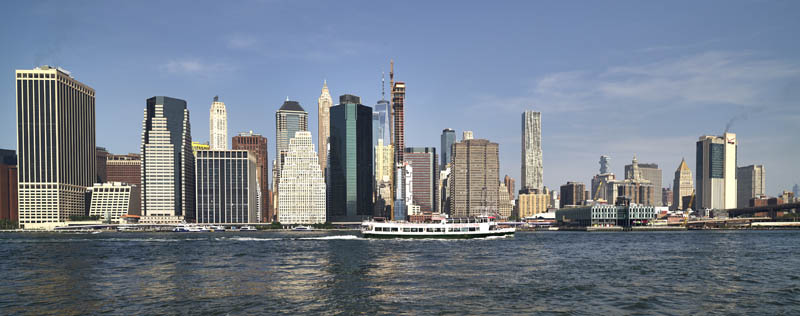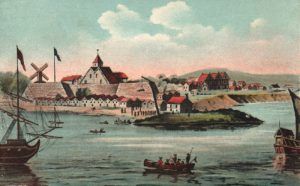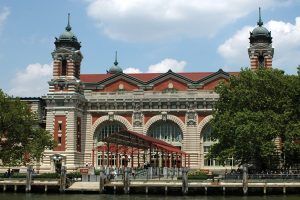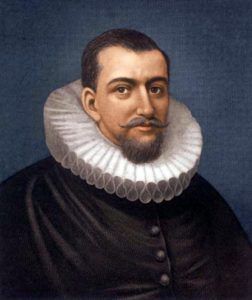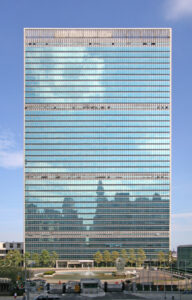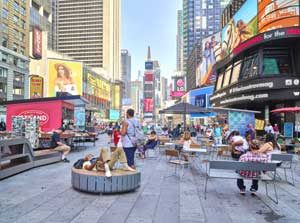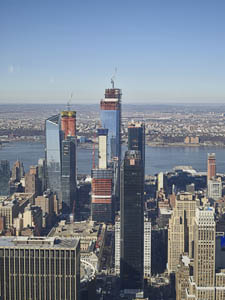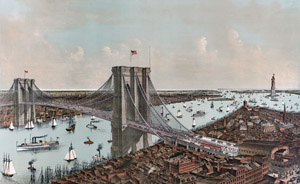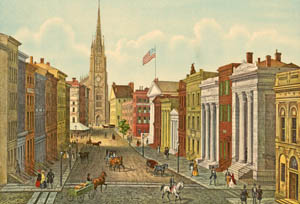New York City History
Discovery, Description & Early Occupation of New York City
The Dutch Colony of New Netherland
Immigration – The First Gateway
New Amsterdam – The Beginnings of New York City
Other Areas
Ellis Island – Island of Hope and Tears
Liberty Island and the Statue of Liberty
More New York City:
Castle Clinton, New York – Anticipating the War of 1812
Historic People of New York City
John Jacob Astor & the American Fur Company
Frederick Douglass – From Slavery to Renowned Activist
Alexander Hamilton – Founding Father & Political Philosopher
Henry Hudson – Northeast Explorer
La Cosa Nostra – American Mafia
Lucky Luciano – Italian Crime Boss of New York
Joe Morello and the Black Handers
Mobster Dutch Schultz & His Hidden Treasure
Elizabeth Cady Stanton – Working For Women’s Equality
New York City, New York, located at the mouth of the Hudson River, is the most populous city in the United States, with a population of 8,804,190 in 2020. It is distributed over 300.46 square miles and is the country’s most densely populated city. It is in southeastern New York State, approximately halfway between Washington, D.C., and Boston, Massachusetts. Most of New York City is built on the three islands of Long Island, Manhattan, and Staten Island. Its urban area extends into adjoining parts of New York, New Jersey, and Connecticut.
The Hudson River flows through the Hudson Valley into New York Bay, separating the city from New Jersey. The East River flows from Long Island Sound, separating the Bronx and Manhattan from Long Island. The Harlem River separates most of Manhattan from the Bronx. The Bronx River, which flows through the Bronx and Westchester County, is the only river in the city that is entirely freshwater.
The city’s total area is 468.484 square miles, of which 302.643 square miles is land and 165.841 square miles is water. The highest point in the city is Todt Hill on Staten Island, which, at 409.8 feet above sea level, is the highest point on the eastern seaboard south of Maine. The ridge’s summit is mainly covered in woodlands as part of the Staten Island Greenbelt.
New York City comprises five boroughs, each coextensive with a respective county. Created in 1898, when local governments were consolidated into a single municipality, the five boroughs are Brooklyn in Kings County, Queens in Queens County, Manhattan in New York County, the Bronx in Bronx County, and Staten Island in Richmond County.
A global city is a cultural, financial, high-tech, entertainment, glamor, and media center with a significant influence on commerce, health care, scientific output, research, technology, education, politics, tourism, dining, art, fashion, and sports.
It is home to the headquarters of the United Nations and is an important center for international diplomacy.
Having long been a premier gateway for immigration to the United States, as many as 800 languages are spoken in the city, making it the most linguistically diverse city in the world. It is also the most ethnically diverse, religiously varied, commercially driven, and famously congested. New York has more Jews than Tel Aviv, more Irish than Dublin, more Italians than Naples, and more Puerto Ricans than San Juan. A city of stark contrasts and deep contradictions, New York is perhaps the most fitting representative of a diverse and powerful nation.
Providing continuous 24/7 service contributes to the nickname The City That Never Sleeps. It is the most visited U.S. city by international visitors.
Anchored by Wall Street in the Financial District of Lower Manhattan, New York City has been called both the world’s leading financial center and the most economically powerful city. It is home to the world’s two largest stock exchanges. New York City has the highest number of billionaires, individuals of ultra-high net worth — greater than U.S. $30 million, and millionaires of any city worldwide. As of 2021, the New York metropolitan area is the second largest metropolitan economy in the world, with a gross metropolitan product of almost $2.0 trillion.
Once the capital of its state and the country, New York surpassed such status to become a world city in commerce, with the most famous skyline on earth. It also became a target for international terrorism — most notably the destruction in 2001 of the World Trade Center, which for three decades had been the most prominent symbol of the city’s global prowess.
Many districts and monuments in New York City are significant landmarks, including three of the world’s ten most-visited tourist attractions in 2023. A record 66.6 million tourists visited New York City in 2019. Times Square is the brightly illuminated hub of the Broadway Theater District, one of the world’s busiest pedestrian intersections, and a significant center of the world’s entertainment industry. Many of the city’s landmarks, skyscrapers, and parks are known worldwide, and the city’s fast pace led to the phrase New York Minute. The Empire State Building is a global reference standard describing other structures’ height and length. New York’s residential and commercial real estate markets are the most expensive in the world.
The New York City Subway is the world’s most extensive single-operator rapid transit system, with 472 passenger rail stations. Penn Station in Midtown Manhattan is the busiest transportation hub in the Western Hemisphere.
The city features over 120 colleges and universities, including some of the world’s top universities. The City University of New York’s public urban university system is the largest in the nation. In the 21st century, New York City has emerged as a global node of creativity and entrepreneurship and as a symbol of freedom and cultural diversity.
The New York Times has won the most Pulitzer Prizes for journalism and remains the U.S. media’s newspaper of record.
New York City is the headquarters of the global art market, with numerous art galleries and auction houses hosting half of the world’s art auctions. The Metropolitan Museum of Art is the largest and second-most-visited art museum in the United States and hosts the globally-focused Met Gala fashion event annually.
Manhattan’s skyline, with its many skyscrapers, is universally recognized, and the city has been home to several of the tallest buildings in the world. Its architecturally noteworthy buildings are in a wide range of styles and from distinct periods, from the Dutch Colonial Pieter Claesen Wyckoff House in Brooklyn, the oldest section of which dates to 1656, to the modern One World Trade Center, the skyscraper at Ground Zero in Lower Manhattan and the most expensive office tower in the world by construction cost.
The Empire State Building, with its Art Deco details and a spire, was the world’s tallest building from 1931 to 1970. The Chrysler Building, built in 1930, was designed in the Art Deco style, with ornamental hubcaps and a spire. The Woolworth Building, an early example of Gothic Revival architecture in skyscraper design, was completed in 1913. For 17 years, it was the world’s tallest building. A highly influential example of the International Style in the United States is the 1957 Seagram Building, which is distinctive for its façade, using visible bronze-toned I-beams to evoke the building’s structure. The Condé Nast Building, built in 2000, is a prominent example of green design in American skyscrapers. It has received an award from the American Institute of Architects and AIA New York State for its design.
There are numerous landmark 19th-century rowhouses, including brownstones, on tree-lined Kent Street in the Greenpoint Historic District of Brooklyn. In Midtown Manhattan, modernist and Gothic Revival architecture can be found. Shabby tenements were built during rapid expansion from 1870 to 1930. In contrast, New York City has less densely populated neighborhoods and free-standing dwellings. In neighborhoods such as Riverdale in the Bronx, Ditmas Park in Brooklyn, and Douglaston in Queens, large single-family homes are common in various architectural styles such as Tudor Revival and Victorian.
Stone and brick became the city’s building materials of choice after the construction of wood-frame houses was limited in the aftermath of the Great Fire of 1835. The roof-mounted wooden water tower is a distinctive feature of many of the city’s buildings. In the 1800s, the city required their installation on buildings higher than six stories to prevent the need for excessively high water pressures at lower elevations, which could break municipal water pipes. Garden apartments became popular during the 1920s in outlying areas, such as Jackson Heights.
No other city has contributed more images to the collective consciousness of Americans: Wall Street means finance, Broadway is synonymous with theatre, Fifth Avenue is automatically paired with shopping, Madison Avenue means the advertising industry, Greenwich Village connotes bohemian lifestyles, Seventh Avenue signifies fashion, Tammany Hall defines machine politics, and Harlem evokes images of the Jazz Age, African American aspirations, and slums. The word tenement brings to mind both the miseries of urban life and the upward mobility of striving immigrant masses.
©Kathy Alexander/Legends of America, January 2024.
Also See:
Sources:

